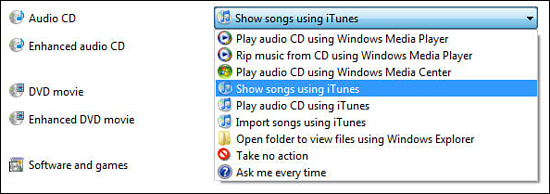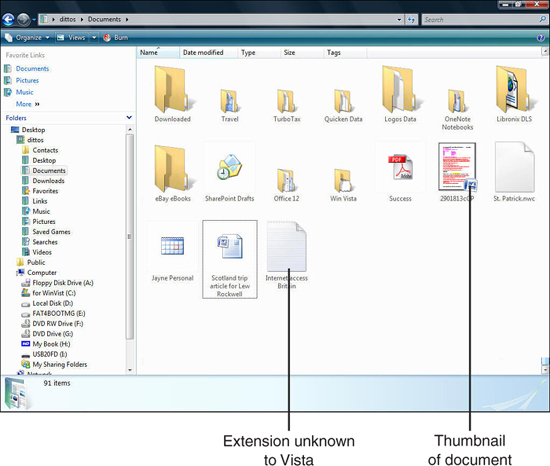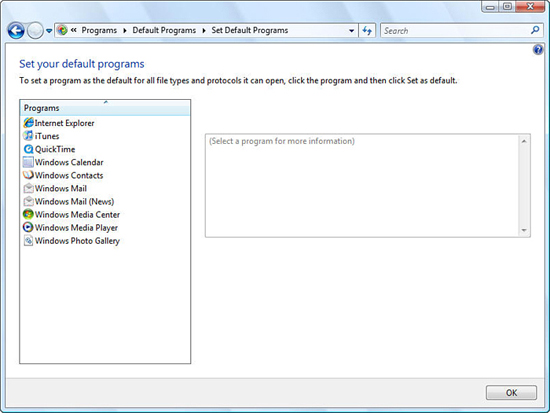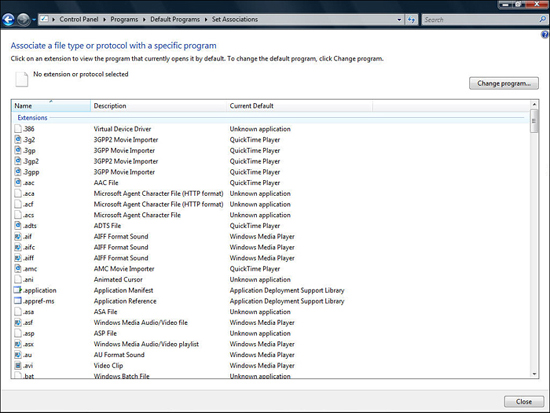Chapter 25. Setting Up Windows Program Defaults
In This Chapter:
- Determine what AutoPlay action occurs when you insert a CD or DVD
- Learn how Windows Vista recognizes different file types
- Limit programs to use only selected file types
- Change your folder options to display filename extensions
- Associate file types to specific programs
- Set your default web browser, instant messenger, email, and media player program
As you use Windows Vista, you’ll notice that Microsoft applied several default settings that you might or might not want to keep. Actually, every one of the scores of options in the Control Panel that you read about in the previous chapter are set to values that Microsoft perceived as being the settings most users would prefer most of the time. You might not be one of those typical users, however, and you want to change some of the more common default behaviors to suit the way you work.
This chapter explores the common default settings that users most often change. One of the most common is the action your computer takes when you insert an audio CD or DVD. Do you want Vista to begin playing the contents immediately or do you want to trigger the play by running a program such as Media Player yourself?
This is a potpourri chapter in that you’ll see how to change default settings across several aspects of Vista. It’s not meant to be a tell-all chapter that shows every default value you could ever set; that would waste your time. Instead, you’ll learn how to make common system changes often requested by Windows users.
Change Media Actions
Open your Control Panel’s Hardware and Sound group and select AutoPlay to change the behavior of your media such as audio CDs and DVDs. The AutoPlay window, shown in Figure 25.1, opens to provide you with the options you can change to reflect your media preferences. All the options on this window describe what happens when you insert or select each type of media content.
Figure 25.1. Tell Windows how you want your media and player defaults set.

Many of the options will show Choose a Default for their selected value. This doesn’t mean that Vista doesn’t already have an option selected because Vista assumes a value for all its options. In other words, if you haven’t selected an action for the Audio CD option, Vista defaults to playing audio CDs with Windows Media Player or, in the case of Vista installations without Media Player, it defaults to a different media player. After you set your own default, that option setting will display.
By the Way
It would be helpful if Vista showed the actual setting instead of displaying Choose a Default, but it does not.
If, as in Figure 25.1, your DVD movie option is set to Play DVD Video Using Windows Media Player, as soon as you insert a DVD movie in your computer’s DVD drive, Windows Media Player begins playing the DVD. If the DVD uses a menu, that menu appears after any initial title and copyright screens appear.
If you’d rather Vista do nothing when you insert a DVD movie into your DVD drive, click the arrow next to this option and select Take No Action, as shown in Figure 25.2. If you regularly burn your own DVD movies and are using Windows Movie Maker, for example, to bring together multiple clips from multiple movies for a collage movie you’re creating, if Media Player began playing the movie as soon as you inserted each disc, stopping the movie’s playback to return to your Movie Maker editing session would get tiring. After you finish making your movie collage, you can reset the AutoPlay option so that your computer automatically begins playing DVD movies when you insert them if that’s your usual preference.
Figure 25.2. You can tell Vista not to play DVDs and CDs automatically when you insert them into your computer’s drives.

The AutoPlay options change as you install and remove media-related programs. For example, if you’ve installed Apple’s iTunes, you can play video and music with iTunes. If iTunes is your preferred media player, change the Audio CD (and any other AutoPlay options you want to play through iTunes) to the Play Audio CD Using iTunes option. As you can see from Figure 25.3, iTunes entries will appear on the drop-down list. Other media players, such as MusicMatch, might also appear on the drop-down settings, making it simple to select your preferred players. You’ll also find Vista’s own Media Center appearing throughout the options if you primarily use your computer as a Media Center PC.
Figure 25.3. Other media players, such as iTunes, will appear in your AutoPlay options if you’ve installed players other than Windows Media Player.

Did you Know?
The AutoPlay options include not only audio and video options, but also game and picture options. For example, you can control what Vista does when you insert a game CD into your disc drive.
Watch Out!
If you’ve set several options and decide that Vista’s default AutoPlay options were better, you don’t have to change back every option. Instead, scroll to the bottom of the AutoPlay window and click Reset All Defaults. Sadly, this causes the AutoPlay options to list, once again, Choose a Default instead of showing the current setting, but you’ll know that the options are back to their original, installed state.
Setting Program-Related Defaults
You don’t just work in Vista all day, you work with programs that run in Vista. Windows Vista is a means to get to your programs. Of course, Vista is an important tool and with Vista you can manage your programs and data effectively, so understanding Vista is critical as you’re learning throughout this book. Nevertheless, your programs are really what matter. No matter what operating system you run, if you use your computer to keep track of your expenses, your accounting program is far more important than the operating system the accounting program runs on.
Therefore, one of the most important aspects of Vista is how it manages and runs your programs. Today’s computers are faster than ever before and if your PC is capable of running Vista, particularly if it can run the Aero user interface, the odds are you have an advanced computer. Having said that, speed isn’t always the only critical factor when running programs. You’ll want to set your Vista-related program defaults so that you get your work done with less effort.
As you saw in the previous chapter, your Control Panel’s Programs group includes an entry called Default Programs. Selecting Default Programs produces the window shown in Figure 25.4 from which you can control program-related actions, such as which programs start automatically every time you turn on your computer as well as associate file types with certain programs that ensure the associated program automatically runs if you select a file of that type from an Explorer window or elsewhere.
Figure 25.4. Set default programs and program-related file types in the Default Programs window.

Each of the next few sections explores many of these program-related options.
Specifying Default Program File Types
Programs and data work together. In reality, your data is the more important of the two. You can always reinstall a program, but if you lose your data, you’ve lost work you’ve done.
In earlier days of computing, users started a program and then loaded the program’s data. This is still done quite often today. You might, for example, start Media Player and then load an MP3 file to listen to using Media Player’s File, Open command. You no longer have to run a program first, however, to work with one of your files. If you double-click an MP3 file from inside a Windows Explorer window, Vista checks to see what program you’ve associated with MP3 files and automatically loads the program and begins playing the music.
You can change programs and their associations. Before learning to do so, a short detour that explains file types is in order.
About File Types
In the Windows environment, your files have an associated file type. This file type is usually determined by the file’s extension which is comprised of three letters at the end of the filename. The file named Word.exe is a program with the extension exe and JanSales.dat is a file with the extension dat. As you can see, a period separates the extension from the rest of the file’s name.
Over the years, programmers have used common extensions to indicate the type of files they create. For example, a file with the .exe extension is a program. A file with the .txt extension is a text file.
Watch Out!
Nothing requires a file to conform to industry standards. You can create a document in Excel, for example, and save that document with the .exe extension by overriding the default extension Excel normally uses for its worksheets. Using common filename extensions incorrectly can cause problems later, however, so it’s best not to rock the boat. In almost all cases, when a program wants to add a certain extension to a file you are saving, accept the program’s default extension.
When you view a file in a Windows Explorer window, Windows looks at the file’s extension and guesses at the type of file it is. Vista then uses its database of file extensions to select an icon for the file. Figure 25.5 shows several files (and folders). The icons on each folder gives you a visual clue as to the type of file you’re looking at. For example, Adobe Acrobat files end in the .pdf filename extension. A file called Success appears in the window and the PDF icon indicates that the file uses the .pdf extension.
Figure 25.5. A file’s extension determines how Vista displays the file in an Explorer window.

Did you Know?
Vista normally hides file extensions, but there are two ways to see them. If you right-click a file and select Properties, you can locate the full filename with its extension in the dialog box. In addition, you can open your Control Panel’s Appearance and Personalization group and select Folder Options, click the View tab, and click to uncheck the Hide Extensions for Known File Types option. When you close the dialog box, Vista displays all extensions in all filenames shown in all Explorer windows.
Sometimes you’ll see more than just an icon that represents an Explorer window’s file. You’ll actually see a small image of the document, as Figure 25.5’s Word file displays. When you save documents in Microsoft Office 2007 and other Vista-aware products, you can select to save a thumbnail image of the first page of the document so you get a mini-preview of the document’s contents. Word includes the Word icon along with that thumbnail preview to confirm that you’re looking at a Word document.
By the Way
If Vista does not recognize a file’s extension, Vista will not be able to display an icon that represents a file type. Vista goes ahead and lists the file’s extension, even if you’ve hidden file extensions, so you can possibly determine for yourself what file type the extension represents.
Set Program Defaults for File Types
Opening the Set Your Default Programs from your Control Panel’s Default Programs group opens the Set Your Default Programs window shown in Figure 25.6. The window includes only Microsoft programs installed with Vista.
Figure 25.6. You can specify which file types certain programs can open.

Here you determine what file types each of the listed programs can open. Click to select a program and then click the Choose Defaults button. A list of every possible file type (shown with each type’s extension) appears. Figure 25.7 shows all the file types that Windows Media Player can play. If you want to use Windows Media Player to play every one of those types, you can click the Select All button and Vista selects every type. If you only want Media Player to play certain file types, click to select only those types.
Figure 25.7. Select any or all file types for the programs to be associated with.

Did you Know?
If you use multiple media players, you might prefer one over the other depending on what you want to experience. For example, you might prefer to use Media Player to listen to your music but prefer QuickTime to watch your videos. To accomplish this, you can set Media Player’s file types to music files only and leave the video-related file types unchecked. Then you’ll set your QuickTime file types to the video file types you want QuickTime to play.
By the Way
Before Vista offered the program default windows you’re learning about in this chapter, you would have to open each program and determine which file types that program was allowed to work with. Sometimes it got confusing as to which program was associated with which file type. Using Vista’s Set Default Programs window simplifies the process dramatically by giving you a way to see all possible file types and selecting from the master list which types go with each program.
Media-related programs aren’t the only programs that you can associate file types to. For example, web-browsing software can display more than just HTML files. You can determine which kinds of web-related pages Internet Explorer and the other web browsers on your computer can access. You might, for example, prefer to use Internet Explorer for HTML files that you view but use an FTP client program such as WS-FTP Pro to view and access FTP-related files. (FTP stands for File Transfer Protocol; FTP programs enable you to transfer multiple files back and forth across Internet and network connections.)
By the Way
Internet web pages are little more than files that have extensions and are stored on web servers. Vista looks at a web page’s extension to determine that page’s file type and then picks your preferred program to view that page.
Associating File Types to Programs Revisited
When you select the Associate a File Type or Protocol with a Program option from your Control Panel’s Default Programs group, you’ll see a list of every known file type on your Vista system and the program that’s associated with that type. You might have associated the program yourself using the previous section’s window, or perhaps Vista was always set to associate that file type and program and you never needed to change the association.
Figure 25.8 shows this window. You see each filename’s extension in the first column followed by a description of that file type and the currently set program associated with the file. Some prefer this file type list when associating programs to file types over the program-centric window described in the previous section. In addition, the Set Your Default Programs window described in the previous section works primarily with Windows-based programs such as Media Player and doesn’t always show non-Windows programs in its list.
Figure 25.8. Select any or all file types for the programs to be associated with.

Did you Know?
The window you start with, the one that shows a list of all known file types or the Set Your Default Programs window described in the previous section that shows a list of Microsoft programs installed on your computer, depends on your approach. If you want to adjust the file types that a certain Microsoft Vista program works with, you might be better off opening the Set Your Default Programs window and selecting from all the file types that program can work with. If, instead, you have a file type that you want to associate to a certain program, whether or not it’s a Microsoft-supplied program, you’ll want to use Figure 25.8’s window to associate a program to a file type.
Suppose that you want a different program to start when you select a digital image file with the gif extension. You click to select the GIF Image file type and then click the Change Program button. Vista displays a list of programs in the Open With window shown in Figure 25.9. The programs toward the top of the window are programs that Vista suggests you use from the list of all programs installed on your computer. Below those suggested programs are other programs you might want to select to associate that file type to. After you click to select a program and click OK, Vista associates that program to that file type and if you ever double-click a file of that type in an Explorer window, Windows Vista automatically opens the program you associated with that type and loads the file. If this is a graphics file, you’ll see the image on the screen. If it’s a music file, the music begins playing when your associated program opens. If it’s a video file type, the associated program automatically opens and begins playing that video when you select the file.
Figure 25.9. Choose the program you want to associate with the selected file type.

There are many reasons why you might want to change an association of a program and its file type. Perhaps the most important reason is your own personal preferences and needs. Photoshop Elements provides far more image-editing capabilities than Windows Photo Gallery. Therefore, you might want to choose all the .gif, .jpeg, .tif, and other digital image file types and associate them all to the Photoshop Elements program you’ve installed.
By the Way
Many times, when you install a program such as Photoshop Elements, the installation routine asks your permission to associate certain file types to the program and updates Vista’s file association tables automatically.
Specifying Default Programs to Run
What Internet browser do you prefer? Internet Explorer? Firefox? Even though Microsoft developed Windows Vista and Internet Explorer, and even though Internet Explorer comes with Vista, you’re free to change your default web-browsing software to a different program.
Selecting the Set Program Access and Computer Defaults option in your Control Panel’s Programs group opens Figure 25.10’s window. When you first open the window you’ll see three entries: Microsoft Windows, Non-Microsoft, and Custom. These expand and collapse as you click the arrows to the right of each option.
Figure 25.10. Determine Vista’s program of choice when performing common computer tasks, such as browsing the Internet.

Each of the three groups represents possible program configurations you can set up. If you only have Microsoft-based web-browsing, email, instant messaging, and media-playing programs installed on your computer, click to open the Microsoft Windows program configuration. There you can choose among the programs you want to use for web browsing, email, sending and receiving instant messages, and playing media files. Actually, you won’t have many choices, depending on what software you’ve installed.
For example, if you’ve installed Microsoft Outlook and set up an email account in Outlook, you will see at least two choices for your email: Outlook and Windows Mail. If you’ve also installed a non-Microsoft email program, you won’t see it as an option in this Microsoft configuration. To set that program as your current email client, you’ll need to select it from the Non-Microsoft or Custom configurations.
Did you Know?
Just because you set program defaults doesn’t mean that you cannot use the other programs when you want to. You can always start Internet Explorer from Vista’s Start menu even if Firefox is your default web browser. Some websites are written for specific browsers and most often the browser is Internet Explorer because of its widespread use. If you normally use Firefox to surf the Internet but need Internet Explorer for specific web pages, use Firefox as your default browser and manually start Internet Explorer from the Start menu when you need to look at web pages that work better with internet Explorer.
Watch Out!
The program defaults you specify apply to all user accounts on your computer. You cannot set up program defaults for your user account and a different set of program defaults for another user who uses your computer.
Expand the Custom configuration and select the default programs you want to use from a combination of both Microsoft and non-Microsoft applications.
Some people get confused when working with this Computer Defaults window and the Program Associations windows. When is it best to select a default media-playing program in one and not the other? Actually, the Computer Defaults window shown in Figure 25.10 has nothing to do with file associations. Instead, it’s a Windows default setting that determines what happens when you click a web link inside a document. Word documents, for example, can contain embedded web links that, when you click them, open your default web browser and send you to the web pages discussed in the document. Other places such as web pages on the Internet include mailto links, which are special links that open your default email program and send email to the address in the mailto link. It’s these kinds of default program settings you set up in the Computer Defaults window. When you want a specific program to begin when you select a certain file type, tell Vista about that in the Associate a File Type or Protocol with a Program window described in the previous section.
Chapter Wrap-Up
Windows Vista gives you the freedom to customize your operating environment in such a way that Windows behaves the way you want it to. You learned here how you can even tell Vista what to do the next time you insert a CD or DVD into your computer’s disc drive.
In an attempt to help you specify your preferred default programs, sometimes Windows Vista helps too much by providing many options and windows that perform similar activities. In this chapter, you saw several ways to specify which file types a certain program can access, which programs should execute when you select certain file types, and default programs that run when you trigger them by clicking links, buttons, and other triggers that start email, web-browsing, instant-messaging, and media-playing programs.
The next chapter explains how you can set up your computer for multiple users. Each user has his or her Vista environment, and can often share files with the other users on the computer depending on the security currently set up.
